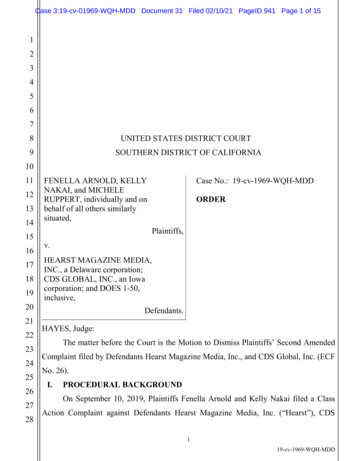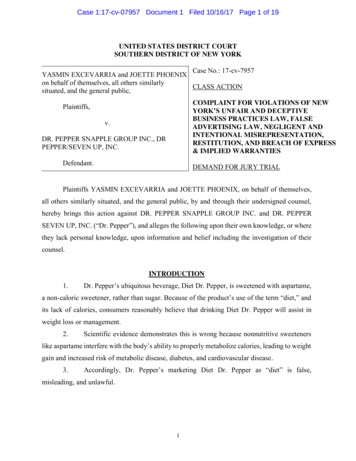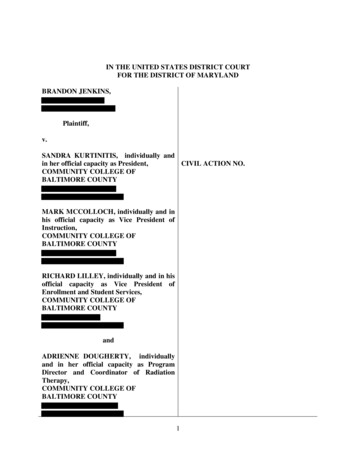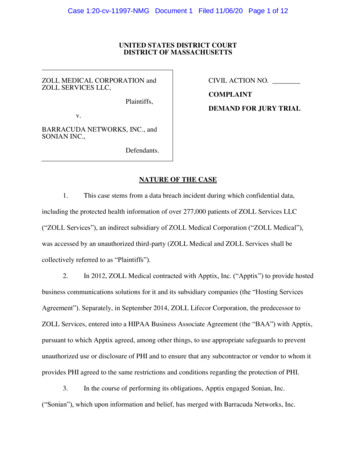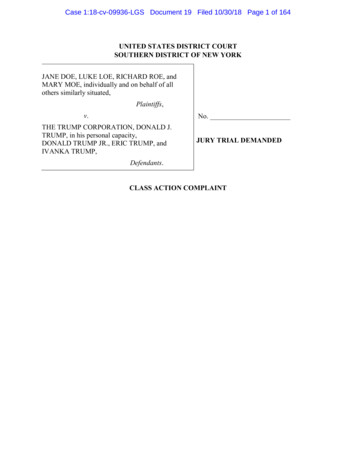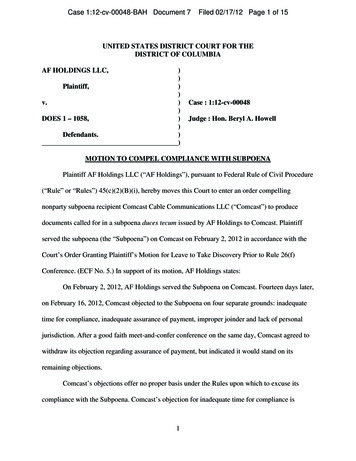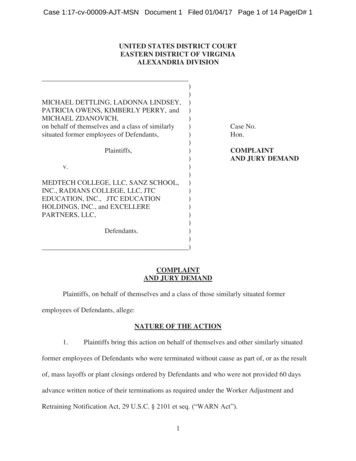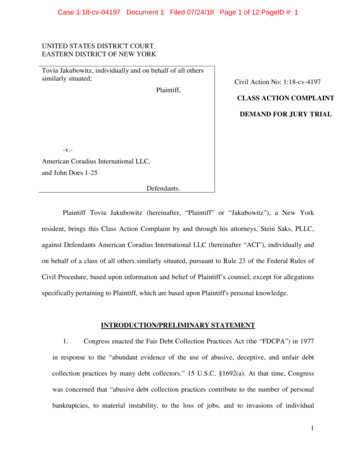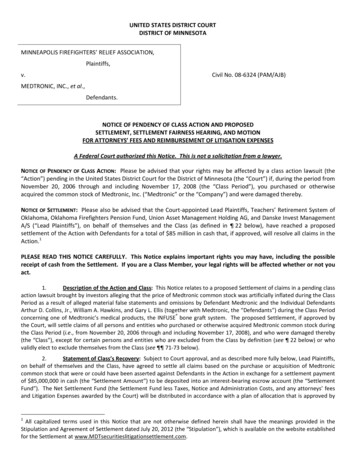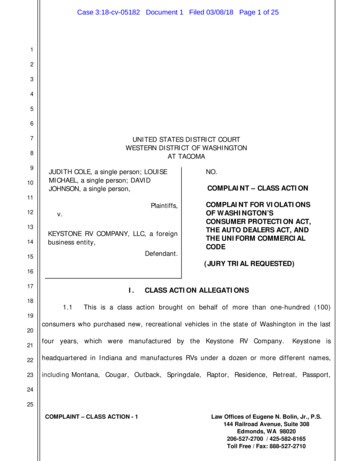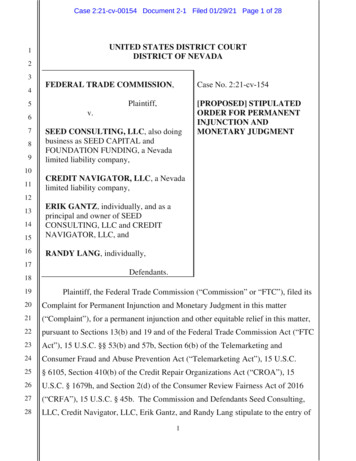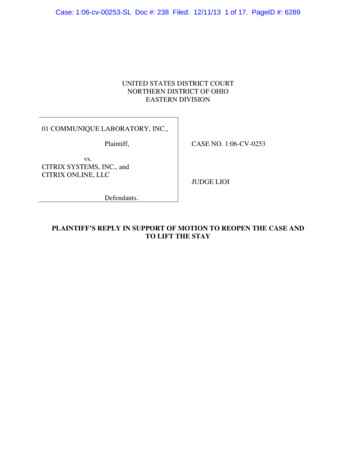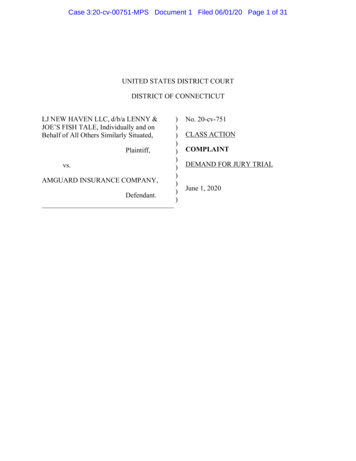
Transcription
Case 3:20-cv-00751-MPS Document 1 Filed 06/01/20 Page 1 of 31UNITED STATES DISTRICT COURTDISTRICT OF CONNECTICUTLJ NEW HAVEN LLC, d/b/a LENNY &JOE’S FISH TALE, Individually and onBehalf of All Others Similarly Situated,Plaintiff,vs.AMGUARD INSURANCE COMPANY,Defendant.)))))))))))No. 20-cv-751CLASS ACTIONCOMPLAINTDEMAND FOR JURY TRIALJune 1, 2020
Case 3:20-cv-00751-MPS Document 1 Filed 06/01/20 Page 2 of 31Plaintiff, LJ New Haven LLC, d/b/a Lenny & Joe’s Fish Tale, by way of Complaint againstDefendant, AmGUARD Insurance Company (together “Defendant” or “AmGUARD”), alleges asfollows:INTRODUCTION1.On March 11, 2020,World Health Organization Director General Tedros AdhanomGhebreyesus declared the COVID-19 outbreak a worldwide pandemic: “WHO has been assessingthis outbreak around the clock and we are deeply concerned both by the alarming levels of spreadand severity, and by the alarming levels of inaction. We have therefore made the assessment thatCOVID-19 can be characterized as a pandemic.”12.On March 16, 2020, the Centers for Disease Control and Prevention, and members ofthe national Coronavirus Task Force issued to the American public guidance, styled as “30 Days toSlow the Spread” for stopping the spread of COVID-19. This guidance advised individuals to adoptfar-reaching social distancing measures, such as working from home, avoiding shopping trips andgatherings of more than 10 people, and staying away from bars, restaurants, and food courts.23.Following this advice for individuals to adopt far-reaching social distancingmeasures, many state government administrations across the nation recognized the need to take stepsto protect the health and safety of their residents from the human to human and surface to humanspread of COVID-19. As a result, many governmental entities entered civil authority orderssuspending or severely curtailing business operations of non-essential businesses that interact withthe public and provide gathering places for the individuals. Currently, almost all states within the1See n-COVID-19 nt/uploads/2020/03/03.16.20 coronavirusguidance 8.5x11 315PM.pdf.
Case 3:20-cv-00751-MPS Document 1 Filed 06/01/20 Page 3 of 31United States have issued some sort of “stay-at-home” order and ordered private non-essentialbusiness operations to close.4.The result of these far-reaching restrictions and prohibitions has been catastrophic formost non-essential businesses, especially restaurants and other foodservice businesses, as well asretail establishments, entertainment venues, and other small, medium, and large businesses who havebeen forced to close, furlough employees, and endure a sudden shutdown of cash flow that threatenstheir survival.5.Restaurants provide economic benefits far beyond their own business. They areanchors to revitalizing down-and-out neighborhoods and can become a tourist attraction themselves,as well as a key part of the identity of smaller cities and large towns.36.In addition to their contribution to the national economy in providing jobs, restaurantsare also vital to the national spirit because shared meals are an important mental relief. As OscarWilde noted, “After a good dinner, one can forgive anybody, even one’s relations.”7.Moreover, food is part of the national psyche. As Anthony Bourdain noted, “Food iseverything we are. It’s an extension of nationalist feeling, ethnic feeling, your personal history, yourprovince, your region, your tribe, your grandma. It’s inseparable from those from the get-go.”8.Most businesses insure against such catastrophic events like the current unforeseenCOVID-19 pandemic through all-risk commercial property insurance policies. These policiespromise to indemnify the policyholder for actual business losses incurred when business operationsare involuntarily suspended, interrupted, curtailed, when access to the premises is prohibited becauseof direct physical loss or damage to the property, or by a civil authority order that restricts us-restaurants-closings.html?action click&module Top%20Stories&pgtype Homepage.-2-
Case 3:20-cv-00751-MPS Document 1 Filed 06/01/20 Page 4 of 31prohibits access to the property. This coverage is commonly known as “business interruptioncoverage” and is standard in most all-risk commercial property insurance policies.9.Defendant, and most insurance companies who have issued all-risk commercialproperty insurance policies with business interruption coverage, are denying the obligation to pay forbusiness income losses and other covered expenses incurred by policyholders for the physical lossand damage to the insured property from measures put in place by the civil authorities to stop thespread of COVID-19 among the population. This action seeks a declaratory judgment that affirmsthat the COVID-19 pandemic and the corresponding response by civil authorities to stop the spreadof the outbreak triggers coverage, has caused physical property loss and damage to the insuredproperty, provides coverage for future civil authority orders that result in future suspensions orcurtailments of business operations, and finds that Defendant are liable for the losses suffered bypolicyholders.10.In addition, this action brings a claim against Defendant for its breach of itscontractual obligation under common all-risk commercial property insurance policies to indemnifyPlaintiff and others similarly situated for business losses and extra expenses, and related lossesresulting from actions taken by civil authorities to stop the human to human and surface to humanspread of the COVID-19 outbreak.11.Plaintiff brings this action on behalf of a proposed class of policyholders who paidpremiums in exchange for business insurance policies that included lost business income and extraexpense coverage.JURISDICTION AND VENUE12.This Court has jurisdiction over this action pursuant to 28 U.S.C. §1332(d) in that thisis a class action in which the amount in controversy exceeds 5,000,000, exclusive of interest and-3-
Case 3:20-cv-00751-MPS Document 1 Filed 06/01/20 Page 5 of 31costs, and at least one member of the putative class is a citizen of a different State than that of theDefendant.13.Venue is proper in this District pursuant to 28 U.S.C. §1391(b) in that Defendant doesbusiness in this District and thus resides in this District, in accordance with 28 U.S.C. §1391(c).PARTIES14.Plaintiff LJ New Haven LLC, d/b/a Lenny & Joe’s Fish Tale (“Lenny & Joe’s”) is aConnecticut limited liability company with its principal place of business in New Haven,Connecticut.15.As a result of the Closure Orders referenced below, Lenny & Joe’s had to ceaseoperations.16.Defendant AmGUARD Insurance Company is a Pennsylvania corporation with itsprincipal place of business in Wilkes-Barre, Pennsylvania. It owns subsidiaries, directly andindirectly, that issue, among other things, property insurance and is duly qualified and licensed toissue insurance in the State of Connecticut and other States.17.AmGUARD issued Policy Number LJBP031708 to Plaintiff for the policy period ofSeptember 4, 2019, through September 4, 2020.FACTUAL BACKGROUNDA.The Global COVID-19 Pandemic18.Viruses of the family Coronaviridae, such as Middle East respiratory syndrome(MERS) coronavirus (MERS-CoV) and severe acute respiratory syndrome (SARS) coronavirus(SARS-CoV), have been responsible for the loss of human life since at least 2002 and wereidentified in several animal hosts.44See -2020.pdf (There are four genera of CoVs: (I) α-coronavirus (alphaCoV),-4-
Case 3:20-cv-00751-MPS Document 1 Filed 06/01/20 Page 6 of 3119.In December 2019, an initial cluster of nine patients with an unknown cause of viralpneumonia was found to be linked to the Huanan seafood market in Wuhan, China, where manynon-aquatic animals such as birds were also on sale. However, one of the patients never visited themarket, though he had stayed in a hotel nearby before the onset of the illness.520.By January 2020, genetic sequencing from patient samples was conducted to identifya novel virus, SARS-CoV-2, as the causative agent for the pneumonia cluster.6 SARS-CoV-2 is anRNA virus, with a crown-like appearance under an electron microscope because of glycoproteinspikes on its envelope. Among the functions of the structural proteins, the envelope has a crucialrole in virus pathogenicity as it promotes viral assembly and release.721.The first confirmed case of the virus outside China was diagnosed on January 13,2020, in Bangkok, Thailand with the number of cases exceedingly increasing worldwide. OnJanuary 30, 2020, the World Health Organization (WHO) declared the SARS-COv-2 outbreakconstituted a public health emergency of international concern, and by February 11, 2020, the virus(II) β-coronavirus (betaCoV) probably present in bats and rodents, while (III) δ-coronavirus(deltaCoV), and (IV) γ-coronavirus (gammaCoV) probably represent avian species).5See https://www.mdpi.com/1660-4601/17/8/2690 (As a typical RNA virus, the averageevolutionary rate for coronaviruses is roughly 10–nucleotide substitutions per site per year, withmutations arising during every replication cycle. This finding suggests that 2019-nCoV originatedfrom one source within a short period and was detected rapidly. However, as the virus transmits tomore individuals, constant surveillance of mutations arising is needed.). See Lu R, Zhao X, Li J,et al. Genomic characterisation and epidemiology of 2019 novel coronavirus: implications for virusorigins and receptor binding. Lancet (London, England). 2020 Feb;395(10224):565-574. DOI:10.1016/s0140-6736(20)30251-8. (This finding suggests either possible droplet transmission or thatthe patient was infected by a currently unknown source. Evidence of clusters of infected familymembers and medical workers has now confirmed the presence of human-to-human 8/2690.7See https://www.mdpi.com/1660-4601/17/8/2690 (To address the pathogenetic mechanismsof SARS-CoV-2, its viral structure and genome must be considered. Coronaviruses are envelopedpositive strand RNA viruses with the largest known RNA genomes—30–32 kb—with a 50 -capstructure and 30 -poly-A tail.).-5-
Case 3:20-cv-00751-MPS Document 1 Filed 06/01/20 Page 7 of 31was named “COVID-19” by the WHO Director-General.8 As of April 15, 2020, the WHO reports aconfirmed 1.9 million cases of COVID-19 globally and over 123,000 deaths, with the United Statesdealing with more than 578,000 confirmed cases and 23,000 deaths - more than any other country.922.The clinical features of COVID-19 vary from asymptomatic forms to fatal conditionsof severe respiratory failure that requires ventilation and support in an intensive care unit (ICU).Pneumonia has been the most frequent severe manifestation of COVID-19, with symptoms of fever,cough, dyspnea, and bilateral infiltrates on chest imaging.10 There are no specific treatmentsrecommended for COVID-19, and no vaccine is currently available; so understanding thecomplexities of COVID-19 is ongoing.1123.It has now been discovered by scientists that COVID-19 has several modes oftransmission. Pursuant to a “Situation Report” released by the WHO, the virus can be transmittedthrough symptomatic transmission, pre-symptomatic transmission, or asymptomatic 8/2690.9https://covid19.who.int/.10See https://www.mdpi.com/1660-4601/17/8/2690 (Asymptomatic infections have also beendescribed, but their frequency is unknown . . . . Other, less common symptoms have includedheadaches, sore throat, and rhinorrhea. Along with respiratory symptoms, gastrointestinal symptoms(e.g., nausea and diarrhea) have also been reported, and in some patients they may be the presentingcomplaint.).11See https://www.mdpi.com/1660-4601/17/8/2690 (The treatment is symptomatic, and oxygentherapy represents the major treatment intervention for patients with severe infection. Mechanicalventilation may be necessary in cases of respiratory failure refractory to oxygen therapy, whereashemodynamic support is essential for managing septic shock [37]. Different strategies can be useddepending on the severity of the patient and local epidemiology [38,39]. Home management isappropriate for asymptomatic or paucisintomatic patients. They need a daily assessment of bodytemperature, blood pressure, oxygen saturation and respiratory symptoms for about 14 days.Management of such patients should focus on prevention of transmission to others and monitoringfor clinical status with prompt hospitalization if covid-19.pdf?sfvrsn 5ae25bc7 2.-6-
Case 3:20-cv-00751-MPS Document 1 Filed 06/01/20 Page 8 of 31Symptomatic transmission refers to transmission by an individual who is experiencing symptomsassociated with the virus who then transfers COVID-19 to another individual. Data from publishedstudies provide evidence that COVID-19 is primarily transmitted from symptomatic people to otherswho are in close contact through respiratory droplets, by direct contact with infected persons, or bycontact with contaminated objects and surfaces.1324.The incubation period for COVID-19, which is the time between exposure to thevirus (becoming infected) and symptom onset, averages 5 -6 days, however, it can be up to14 days.14 During this period, also known as the “presymptomatic” period, some infected personscan be contagious. For that reason, transmission from a pre-symptomatic case can occur beforesymptom onset. Presymptomatic transmission still requires the virus to be spread through infectiousdroplets or touching contaminated surfaces.1513See f?sfvrsn 5ae25bc7 2 (Data from clinical and virologic studies that have collectedrepeated biological samples from confirmed patients provide evidence that shedding of the COVID19 virus is highest in upper respiratory tract (nose and throat) early in the course of the disease. Thatis, within the first 3 days from onset of symptoms. Preliminary data suggests that people may bemore contagious around the time of symptom onset as compared to later on in the covid-19.pdf?sfvrsn 5ae25bc7 215See f?sfvrsn 5ae25bc7 2 (In a small number of case reports and studies, presymptomatic transmission has been documented through contact tracing efforts and enhancedinvestigation of clusters of confirmed cases. This is supported by data suggesting that some peoplecan test positive for COVID-19 from 1-3 days before they develop symptoms. Thus, it is possiblethat people infected with COVID-19 could transmit the virus before significant symptoms develop.)-7-
Case 3:20-cv-00751-MPS Document 1 Filed 06/01/20 Page 9 of 3125.An individual who does not develop symptoms, an asymptomatic case of COVID-19,can still transmit the virus to another. Though there are few documented cases reported, it does notexclude the possibility that it has or may occur.1626.Not only is COVID-19 transmitted via human-to-human, but the WHO and scientificstudies have confirmed that the virus can live on contaminated objects or surfaces. According to astudy by scientists documented in The New England Journal of Medicine, COVID-19 was detectablein aerosols for up to three hours, up to four hours on copper, up to 24 hours on cardboard, and up totwo to three days on plastic and stainless steel.17 All of these materials are used in the preparationand service of food by restaurants. The results of the study suggest that individuals could getCOVID-19 through indirect contact with surfaces or objects used by an infected person, whetherthey were symptomatic.27.Another scientific study documented in the Journal of Hospital Infection found thathuman coronaviruses, such as SARS-CoV and MERS-CoV can remain infectious on inanimatesurfaces at room temperature for up to nine days.18 At a temperature of 30 degrees Celsius or more,the duration of persistence is shorter. Contamination of frequently touched surfaces is, therefore, .pdf?sfvrsn 5ae25bc7 2.17See coronavirus-stable-hours-surfaces;See lications-for-ipc-precaution-recommendations (In the context of COVID-19, airbornetransmission may be possible in specific circumstances and settings in which procedures or supporttreatments that generate aerosols are performed; i.e., endotracheal intubation, bronchoscopy, opensuctioning, administration of nebulized treatment, manual ventilation before intubation, turning thepatient to the prone position, disconnecting the patient from the ventilator, non-invasive positivepressure ventilation, tracheostomy, and cardiopulmonary resuscitation.).18See showPdf?pii S01956701%2820%2930046-3.-8-
Case 3:20-cv-00751-MPS Document 1 Filed 06/01/20 Page 10 of 31potential source of viral transmission.19 Though this study was not conclusive on COVID-19 itself,scientists are still grappling to understand this implication.28.On March 27, 2020, the Centers for Disease Control and Prevention (“CDC”)released a report entitled “Public Health Responses to COVID-19 Outbreaks on Cruise Ships –Worldwide, February – March 2020.”20 The report detailed that during this time frame, COVID-19outbreaks associated with three different cruise ship voyages caused over 800 confirmed cases and10 deaths.21 Of the individuals tested, a high proportion were found to be asymptomatic, which mayexplain the high rates on cruise ships. What is interesting about this study though, is that COVID-19was identified on a variety of surfaces in cabins of both symptomatic and asymptomatic infectedpassengers up to 17 days after cabins were vacated on the Diamond Princess cruise line, but beforedisinfection procedures had been conducted.22 The CDC notes that more studies are required to19See showPdf?pii S0195-6701%2820%2930046-3 (Although the viral load of coronaviruses on inanimate surfaces is not known during anoutbreak situation it seem plausible to reduce the viral load on surfaces by disinfection, especially offrequently touched surfaces in the immediate patient surrounding where the highest viral load can beexpected. The WHO recommends “to ensure that environmental cleaning and disinfectionprocedures are followed consistently and 69/wr/mm6912e3.htm?s cid mm6912e3 12e3.htm?s cid mm6912e3 w(During February 7–23, 2020, the largest cluster of COVID-19 cases outside mainland Chinaoccurred on the Diamond Princess cruise ship, which was quarantined in the port of Yokohama,Japan, on February 3 (3). On March 6, cases of COVID-19 were identified in persons on the GrandPrincess cruise ship off the coast of California; that ship was subsequently quarantined. ByMarch 17, confirmed cases of COVID-19 had been associated with at least 25 additional cruise shipvoyages. On February 21, CDC recommended avoiding travel on cruise ships in Southeast Asia; onMarch 8, this recommendation was broadened to include deferring all cruise ship travel worldwidefor those with underlying health condi
16. Defendant AmGUARD Insurance Company is a Pennsylvania corporation with its principal place of business in Wilkes-Barre, Pennsylvania. It owns subsidiaries, directly and indirectly, that issue, among other things, property insurance and is duly qualified and licensed to issue in
